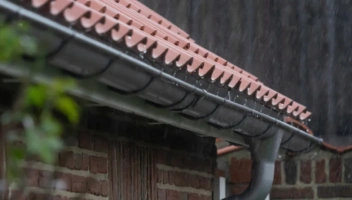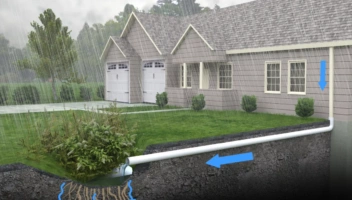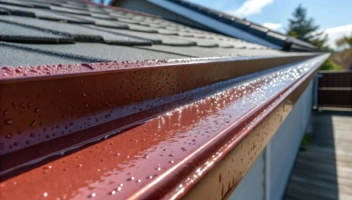Gutter Cleaning: The Ultimate Guide for Homeowners

Not many of us can honestly say we enjoy cleaning out gutters, but gutter maintenance is one of those essential tasks that shouldn’t be overlooked. The ramifications of neglecting this can lead to various issues, including water damage and foundation problems.
Many homeowners take a DIY approach to gutter cleaning, but this can cause additional problems if not done correctly.
In this guide, we’ll take a look at exactly how to clean gutters, considerations to keep in mind, and other information you need to know to ensure your safety and prevent damage to your home.
In this article:
- Why Gutter Cleaning Matters
- Getting Started with Gutter Cleaning
- Step-by-Step Guide: How to Clean Out Gutters from a Ladder
- Ideas for Cleaning Gutters from the Ground
- Gutter Cleaning and Timing Considerations
- Professional Gutter Cleaning
- DIY Gutter Cleaning Pros and Cons
- Preventing Gutter Clogs With Gutter Guards
- Final Thoughts
- Frequently Asked Questions
Why Gutter Cleaning Matters
The concept of gutters is simple enough. When it rains, water flows off your roof and, ideally, into your gutters, which then channel it toward your downspouts. These then carry the water down and away from your foundation and walls, preventing leaks and damage to your foundation.
Unfortunately, the simplicity of the design can also lend itself to problems over time, as leaves, twigs, and dirt accumulate in your gutters. This leads to clogs, which prevent the water from channeling away from the house properly.
The water overflows the gutters, and can eventually find its way inside. This can result in mold, wood rot, and even interior damage. In addition, the accumulated debris can pose a fire hazard, with previous water damage leaving your home more vulnerable. For example, decayed roof deck boards may be easily ignited should the debris in the gutters catch fire.
This is why keeping your gutters clean is so essential to the overall well-being of your home. Regularly cleaning out your gutters can prevent this damage and maintain your house’s structural integrity.
Getting Started with Gutter Cleaning
As you may know, cleaning out gutters isn’t just a matter of setting up a ladder and grabbing a trowel. To ensure your safety, and to save time and energy, it’s best to first consider what tools and supplies you’ll need to have on hand as well as what safety measures you’ll need to implement to reduce the risk of injury.
First, if you’ll be climbing a ladder, it’s important to have another adult nearby, ideally outside. If you don’t have a helper physically available, it wouldn’t hurt to let someone know you’ll be working on a ladder and that you’ll call or text when you’re done.
This way, there’s someone who can check in on you if they don’t hear from you.
Wear non-slip shoes to prevent falls, and be sure to have durable work gloves and safety goggles. Other useful tools include a bucket, a gutter scoop, a garden hose with a high-pressure spray attachment, and a broom or rake.
Step-by-Step Guide: How to Clean Out Gutters from a Ladder
While it’s not the safest option, using a ladder allows you to see exactly what’s happening inside your gutters. It also puts you in a position to manually remove large clogs.
Follow the steps below for cleaning gutters when using a ladder.
Step 1: Set Up Your Work Area
Make sure the ladder is stable, and ensure you have your bucket, scoop, and other tools on hand. Wear your safety goggles and gloves. This is not overkill; you might encounter sharp debris or even a sharp edge on the gutter itself.
Step 2: Clear the Debris from the Roof
You don’t need to get onto the roof and walk around. Instead, use your broom to push away any pine needles, leaves, or twigs near the gutters. This prevents the debris from falling into the gutters during or after the cleaning process. Reposition your ladder as needed to avoid leaning or overreaching.
Step 3: Scoop Out the Debris from Your Gutters
Starting at a downspout, use your trowel to scoop the goop from your gutters and into your bucket, emptying it as necessary into a wheelbarrow below. (Pro tip: place a tarp under the wheelbarrow to catch what you will inevitably drop.) Work away from the downspout to prevent debris from falling into it and potentially causing additional clogs.
Step 4: Flush the Downspouts
Use your hose and put the nozzle on the highest pressure. Direct the water into the downspouts to flush out any debris. If the water doesn’t run smoothly, move on to step 5. If it does, you can skip step 5 and go to step 6.
Step 5: Manually Clean Out the Downspouts
If a downspout is clogged, you’ll want to remove the elbow to see if that’s where the clog is located. If so, just clean it out manually, replace it, and flush the entire thing to be sure it’s clear.
You can also use a plumber’s snake to clean it out. Start from the bottom and rotate it slowly as it goes up the pipe. That should work effectively enough to allow you to flush out any broken-up clogs from the top.
Step 6: Flush Out the Gutters
Hose out the gutters to remove any leftover dirt or small pieces of debris. You can do this from the ladder or use a gutter wand to do it from the ground.
Step 7: Clean Up Your Work Area
Dispose of the leaves and dirt you scooped out of the gutters, and put all your tools away.
Ideas for Cleaning Gutters from the Ground
You don’t need to climb a ladder to clean out your gutters if they’re not badly clogged. If it’s just a typical light accumulation of leaves and pine needles, using a gutter wand or simply the garden hose from the ground might be enough to flush out the debris.
A gutter wand is a long attachment for your hose that uses a stream of water to clean out the pipes from above. The water will run down the downspouts, so you’ll want to ensure they’re clear.
You might also consider using a leaf blower with an attachment, or even a power washer. Be sure you know how to use these safely, and be careful not to damage the gutters (or the soffit or fascia) if you’re using a power washer.
A more hands-off option is a gutter-cleaning robot. You’ll still need to climb a ladder to access the gutters, but then you can simply place the robot in the gutters and use the remote control to send it around the perimeter of the home, pushing out any debris along the way.
Check out the video below to learn more about some of the commonly used gutter-cleaning tools:
<iframe width=”560″ height=”315″ src=”https://www.youtube.com/embed/JPstc4Y1wi4″ title=”YouTube video player” frameborder=”0″ allow=”accelerometer; autoplay; clipboard-write; encrypted-media; gyroscope; picture-in-picture; web-share” allowfullscreen></iframe>
Gutter Cleaning and Timing Considerations
How frequently you need to clean out your gutters will depend upon your home and your surrounding environment. As a general rule, you should clean out your gutters at least twice a year. The typical times are in the late spring after the trees have dropped their blossoms, and then again in the fall after the leaves have fallen—which is also a great time to winterize your gutters.
However, if you have a lot of trees overhanging your house, you might need to do this more frequently. Alternatively, if you live in an area without deciduous trees that shed their leaves, you may be able to get away with cleaning out your gutters just twice per year. For reference, it typically takes a few hours to clean gutters.
If you notice water overflowing your gutters, it’s time to clean them out, regardless of whether it’s been just a couple of months or a whole year since the last time you cleaned them out.
Professional Gutter Cleaning
While many homeowners choose to clean out their gutters on their own, this isn’t something you should try unless you are comfortable with heights, have the right equipment and have taken the proper safety precautions to prevent a fall.
Fortunately, hiring a professional is always an option. Professionals will use different methods, depending on your specific gutters, how much debris is accumulated, and the condition of the gutters themselves. They might use pressure washing, vacuuming, manual cleaning, or a combination of all three, to ensure a thorough job.
A professional gutter cleaner might work from a ladder or from the roof itself. They’re well-versed in safety measures and will be comfortable on your roof, allowing you to relax with the knowledge that your gutters will be cleaned out without the risk of physical harm to yourself or damage to your property.
DIY Gutter Cleaning Pros and Cons
When deciding between cleaning out your gutters yourself or hiring a professional, it can be helpful to review a list of potential benefits and disadvantages.
Pros of DIY Gutter Cleaning
- You may save money. Note that this is not a given; if you need to purchase a ladder, buckets, trowel, pressure washer, and other supplies, you might not save any money at all, at least not in the short term. But if you already have most of the tools, you won’t incur many costs by doing it yourself. However, keep in mind that if you don’t adequately clean out and maintain your gutters, you’ll likely be facing some costly damages, such as roofing damage, basement flooding, or even damage to your home’s foundation, that may not be covered by your homeowner’s insurance.
- You can check the roof while you’re at it. Climbing a ladder and examining the roof yourself can give you invaluable information about its condition, including whether any shingles are lifting, if the soffit is damaged, and so on.
- You can do this on your own schedule. Take a planned Saturday afternoon to clean out the gutters, or get it done on the fly if you notice your gutters overflowing. If you DIY, you won’t need to work around anyone else’s schedule.
- You might learn a new skill. If you like to accomplish these types of projects on your own, you’ll enjoy the sense of achievement as well as the hands-on experience you’ll gain.
Cons of DIY Gutter Cleaning
- You might be taking a safety risk. Being on a ladder, on the roof, and wrangling potentially awkward equipment isn’t for the inexperienced. A fall is always possible, and if you lack experience, the risks are even greater.
- You’ll be spending your own time dealing with a messy job. Some people have limited free time and might not want to spend it on a dirty task like cleaning out gutters. It also takes some physical effort to manage the climbing, carrying, and cleaning out the debris.
- You might have limited equipment. Chances are, you don’t have specialized tools like a high-reach vacuum system or a pressure washer. If you’re using basic tools, you might not be able to successfully complete the job—and that can mean big expenses later, such as the need to repair or place a damaged roof, address a flooded basement, replace damaged gutters, or repair a damaged foundation.
- You may not be able to reach every area of the gutters. It might be impossible to reach some of your gutters via a ladder, especially if you have a two- or three-story home. You could miss clogs without even knowing they were there in the first place, and again, if you miss just enough debris to allow your gutters to clog, you’ll be risking costly water damage to your home.
Preventing Gutter Clogs with Gutter Guards
Regularly cleaning out your gutters can help prevent large gutter clogs that get into your downspouts or block water from flowing smoothly, with most experts recommending twice-yearly cleaning in most environments.
Fortunately, one inexpensive but highly effective way to prevent clogged gutters is to install gutter guards. These are guards made of aluminum, lightweight metal, nylon mesh, or plastic, and they sit inside or top on your gutters to help keep debris out while still allowing rainwater through. Gutter guards prevent clogs by not allowing leaves, sticks, and other debris into the gutters or downspouts.
There are a number of different gutter guards on the market, but make sure you choose a proven solution to end clogged gutters—and the need to clean them out—for good.
Final Thoughts
Cleaning out gutters isn’t a fun chore—trust us, we get it! While it’s no one’s idea of a great time, we encourage you to take the task seriously as neglecting it can cause serious problems. It’s important to get yourself set up well with safety tips to avoid damage to your roof, gutters, or other outdoor areas.
Hiring a professional to clean out your gutters is a good option if you’re not sure you want to tackle the job yourself, but hiring the experts at LeafFilter to install our proven gutter guards is the BEST option. Our patented technology will help you check off the chore of cleaning out your gutters. Which means more time for the things you love. Call us today toll-free at 1-800-290-6106 for a free estimate, or visit LeafFilter.com to learn more.
Frequently Asked Questions
Here are some frequently asked questions about how to clean out gutters and keep your gutters clean in general.
Why is it important to clean gutters?
Cleaning out your gutters isn’t an enjoyable task, but it’s a necessary one to protect your home from the potential water damage that results from clogged gutters. Clogged gutters prevent water from flowing into your gutters and through your downspouts, which direct the water away from your home.
When leaves and other debris clog your gutters, the water cannot flow through. That means the water isn’t directed away from your home. Instead, it overflows and can result in cracks, shifting, and damage to your foundation.
The water can even eventually seep into the walls, causing various issues such as rotting wood, damaged siding, unsightly stains in walls and ceilings inside the home, and damage to electrical systems. Stagnant water that accumulates in clogged gutters also provides ideal conditions for insects, mold, and mildew, which can pose a serious health risk to your family.
Cleaning gutters helps to prevent clogs, allowing water to flow through your rain gutters, into your downspouts, and away from your home.
How much is professional gutter cleaning?
Hiring a professional to clean your gutters can cost from under one hundred dollars to several hundred dollars or more. It depends on quite a few factors, including how many linear feet of gutters you’re talking about, the condition they’re in, whether they’re badly clogged, and how many stories your house is. It’s a good practice to get several quotes from licensed and insured professionals before choosing one.
What’s the quickest way to clean gutters?
If you don’t want to drag out a ladder and other materials to clean out your gutters, try using a wet/dry vac with an attachment or a gutter wand. Both of these will allow you to blow, vacuum, or rinse out your gutters without a lot of setup or cleanup. Note that if you’re using a wet/dry vacuum, you’ll want to be sure the debris in the gutters is as dry as possible.
How do you clean the outside of gutters without a ladder?
You can use a garden hose to wet down your gutters, then use a deck brush with a soapy solution to carefully scrub off the outside of your gutters. A power washer is also an option, but if you have the pressure set too high or if your gutters aren’t in good shape, you could cause damage to them or other parts of your house.
What happens if water sits in the gutters?
Stagnant water will often become contaminated with decomposing leaves, twigs, bird droppings, and other organic materials, resulting in a thickened sludge. This can become home to mosquito larvae, which will turn into mosquitos.
It will also draw other types of insects, some of which might bite or sting. In some cases, sitting water can cause rust, which can lead to holes in the gutters. Take care of clogs and remove standing water as soon as you notice it.
Gutter Cleaning Near You:
- Gutter cleaning in Richmond, Virginia
- Gutter cleaning in Columbus, Ohio
- Gutter cleaning in Raleigh, North Carolina
- Gutter cleaning in Cincinnati, Ohio
- Gutter cleaning in Louisville, Kentucky
- Gutter cleaning in Atlanta, Georgia
- Gutter cleaning in Greenville, South Carolina
- Gutter cleaning in Nashville, Tennessee


